
Spring Allergies in Pets: Symptoms to Watch for and How to Help
Spring is a season of renewal—flowers bloom, the sun shines longer, and everything seems to come alive. But while many people welcome the season with open arms, our pets may not feel the same excitement. Just like humans, pets can suffer from seasonal allergies, especially during spring when pollen, mold, and dust mites are on the rise.
Spring allergies in pets can be more than just a minor annoyance. Left untreated, they can cause chronic discomfort, infections, and behavioral changes. The good news? With awareness and timely action, you can help your furry companion get back to feeling their best.
In this article, we’ll explore the signs of spring allergies in dogs and cats, compare how allergies affect each species, and offer practical solutions for managing symptoms.
What Causes Spring Allergies in Pets?
Springtime allergens that commonly affect pets include:
- Tree and grass pollen
- Weeds and blooming plants
- Mold spores from damp soil or leaves
- Dust mites and household irritants that increase with open windows
- Fleas, which become more active in warmer months
When pets inhale or come into contact with these allergens, their immune systems may overreact, leading to a variety of symptoms.
Common Symptoms of Spring Allergies in Pets
Identifying the signs early is essential for relief and prevention of more serious issues.
In Dogs:
- Excessive scratching or licking, especially paws and belly
- Red, inflamed skin or hot spots
- Watery or itchy eyes
- Ear infections or frequent head shaking
- Sneezing or coughing
- Hair loss in affected areas
In Cats:
- Over-grooming (especially abdomen and legs)
- Sneezing or nasal discharge
- Coughing (sometimes mistaken for hairballs)
- Red, itchy ears
- Skin lesions or scabs
- Irritability or hiding more than usual
Not all symptoms will appear at once, and some can be subtle—especially in cats who tend to hide discomfort.
Comparison Table: Spring Allergy Symptoms in Dogs vs. Cats
| Symptom | Dogs | Cats |
|---|---|---|
| Scratching | Very common | Less obvious |
| Paw licking/chewing | Frequent | Occasional |
| Sneezing | Common | Common |
| Watery eyes | Frequent | Less common |
| Ear infections | Frequent | Occasional |
| Coughing | Mild to moderate | Can mimic hairballs |
| Overgrooming | Rare | Very common |
| Skin redness or hot spots | Common | Possible |
| Behavioral changes | Subtle | Often more obvious |
How to Help Pets with Spring Allergies
If you suspect your pet is suffering from allergies, there are several ways to manage symptoms and improve their comfort—ranging from simple lifestyle changes to veterinary care.
1. Visit the Veterinarian
Always start with a proper diagnosis. Some symptoms of spring allergies can mimic other conditions like parasites, infections, or even food allergies.
Your vet may recommend:
- Skin tests or blood allergy panels
- Prescription medications like antihistamines, corticosteroids, or immune-modulating drugs
- Topical treatments or medicated shampoos
- Flea prevention, as fleas can worsen allergic reactions
2. Limit Exposure to Allergens
This may sound tricky, but a few adjustments can make a big difference:
- Wipe down your pet’s paws and coat after outdoor walks.
- Keep them indoors during high pollen hours (usually early morning and evening).
- Use HEPA air filters and regularly clean floors and fabrics.
- Avoid lawn treatments or gardening chemicals that could irritate sensitive skin.
- Bathe your pet weekly with a gentle, vet-approved shampoo.
3. Improve Indoor Air Quality
During spring, it’s tempting to keep windows open—but this can invite pollen indoors. Use:
- Air purifiers
- Vacuum cleaners with pet-friendly filters
- Wash pet bedding frequently
Also, make sure your home is free from mold and dust, especially in damp corners, under furniture, and around window sills.
4. Adjust Your Pet’s Diet
A healthy immune system starts with a good diet. Some pets benefit from:
- Omega-3 fatty acids (to reduce inflammation)
- Hypoallergenic diets if food sensitivities are suspected
- Probiotics to support gut health and immunity
Discuss dietary options with your vet before making changes.
5. Medications and Treatments
Depending on severity, your vet may suggest:
- Antihistamines (e.g., Benadryl or Zyrtec, always at vet-approved doses)
- Steroids for short-term relief
- Cytopoint injections (dogs only)
- Apoquel (oral medication for allergic itch in dogs)
- Atopica or similar immune-suppressants
- Allergy shots (immunotherapy) for long-term control
These can reduce the body’s response to allergens and offer lasting relief, especially for pets with chronic allergies.
Preventive Tips for Spring Allergy Season
- Keep your pet’s coat well-groomed to reduce allergen buildup.
- Use non-toxic lawn care if your pet spends time outside.
- Choose pet-safe detergents and cleaners to wash bedding and toys.
- Monitor local pollen levels and adjust outdoor time accordingly.
- Use flea preventatives year-round to avoid flea allergy dermatitis.
FAQs
Q: Can pets develop allergies later in life?
A: Yes. Pets can develop environmental or seasonal allergies at any age—even if they’ve never shown symptoms before.
Q: How can I tell the difference between spring allergies and food allergies?
A: Food allergies often cause year-round symptoms and affect the ears and gastrointestinal system. Spring allergies are seasonal and typically linked to outdoor allergens.
Q: Are certain breeds more prone to allergies?
A: Yes. Breeds like Bulldogs, Retrievers, Terriers, and Siamese cats are more prone to allergies due to genetic factors.
Q: Can I give my pet human allergy medicine?
A: Some antihistamines (like Benadryl) can be used under veterinary guidance. Never give medications without consulting your vet first.
Q: Is there a cure for spring allergies in pets?
A: There’s no cure, but with consistent care, symptoms can be managed and greatly reduced, ensuring your pet’s comfort during allergy season.
Image Designed Using Canva
